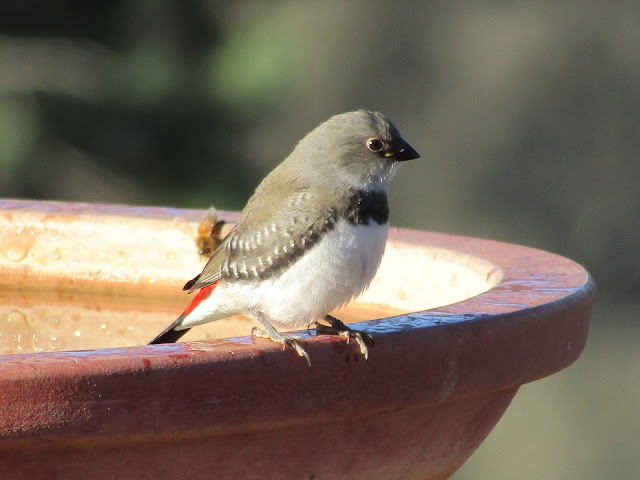
We had such warm autumn on the farm, some birds
were confused and thought it was spring. Diamond Firetail Finches breed August to January but have already fledged some dainty fellas in mid-winter.
 Through May there was strange behaviour as male Firetails blew themselves
up into fluff balls. Double normal size, standing impossibly tall on stretched
legs, they flew past with a strand of grass three times their length.
Through May there was strange behaviour as male Firetails blew themselves
up into fluff balls. Double normal size, standing impossibly tall on stretched
legs, they flew past with a strand of grass three times their length.There are plenty of dead branches on the gums near our house. The male flies to one and bobs up and down with his bill on his breast. Singing a long, raspy song to potential mates it display bounces while holding the stem on one end. The red, black and white balls go into a manic series of knee bends like some wacky version of bird aerobics.
 The female is completely mesmerised, as am I. The Diamond finch bows, presenting the grass he’s been
holding like a tight rope artist all along. To thank him for the quirky dance, she quivers and shakes her tail feathers. This is the Firetail
signal to get it on.
The female is completely mesmerised, as am I. The Diamond finch bows, presenting the grass he’s been
holding like a tight rope artist all along. To thank him for the quirky dance, she quivers and shakes her tail feathers. This is the Firetail
signal to get it on.The piece of grass is symbolic for the nest build. The pair make lots of call-and-answer tweets in the ten days it takes to build their large, bottle-shaped nest. As most mistletoe has died out in our long drought, the diamonds chose our ivy-covered tree for a well-protected site.The ivy is densely packed, almost two feet deep around the tree truck.
I knew
the finches must be nesting by the sheer amount of long grass they transferred to
and from the ivy. I couldn’t believe they’d breed at the onset
of winter. I guess that’s global warming in action. The higher temperatures are confusing them.
Heading down the road to water some palms at the start of July, I was dive-bombed. A parent Firetail almost scalped me. I went back after a couple of hours to find the nest. It was just above my head, deep inside the foliage. I clicked off some photos. Hearing the babes squeaking again inside, I backed away. Too late, both parents flew out and almost smacked me in the mouth. I left them alone to parent, giggling as I walked back home.
 |
| The opening of the Firetail Finch nest, which droops down into an enormous bowl big enough for lots of birds. |
All weekend, I’ve been spotting Diamond Firetail chicks.
Eyes are
brown, instead of red and beaks are grey-black.
Their plumage
is much more subdued, no bright fire-engine red tail, they are shades of grey.
Diamond shaped spots are indistinct in what is left of downy fluff.
I can’t remember seeing young finches
like these before.
 |
| They have small yellow bars at the sides of their mouths, looking like a different bird from the vibrant adults. See the difference? |

I take a wobbly two second film as a parent bird is dived on by a baby. I don’t know whether the juvenile couldn’t yet fly straight or simply thought it might hop on pop.
There’s a bit over two weeks until spring, and we are in a Polar cold snap at the moment, but the
birds and their babes are already full of surprises.
 |
| Twin juvenile Diamond Firetail Finches sharing the bath with a wet (not so) Superb Fairy Wren. |
 | ||||||||||||||||
| They might not have as much fire in their tails and their diamonds are definitely not as bright, but these juvenile finches still shine for me in my garden. |







No comments:
Post a Comment